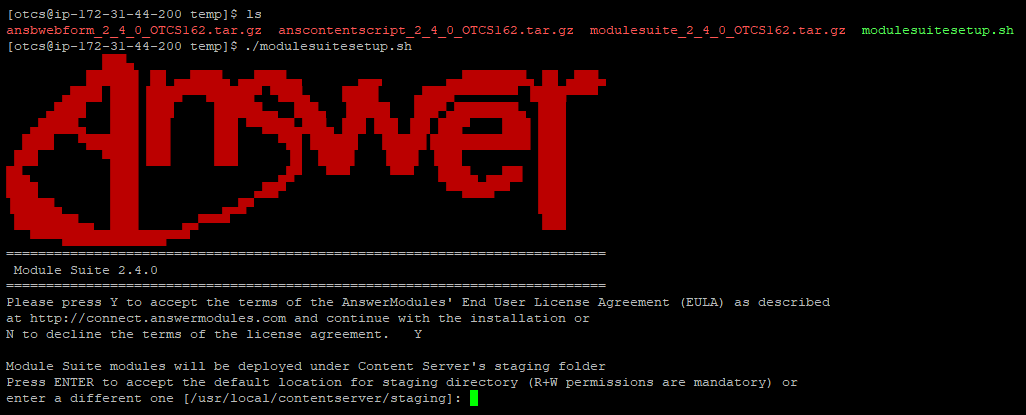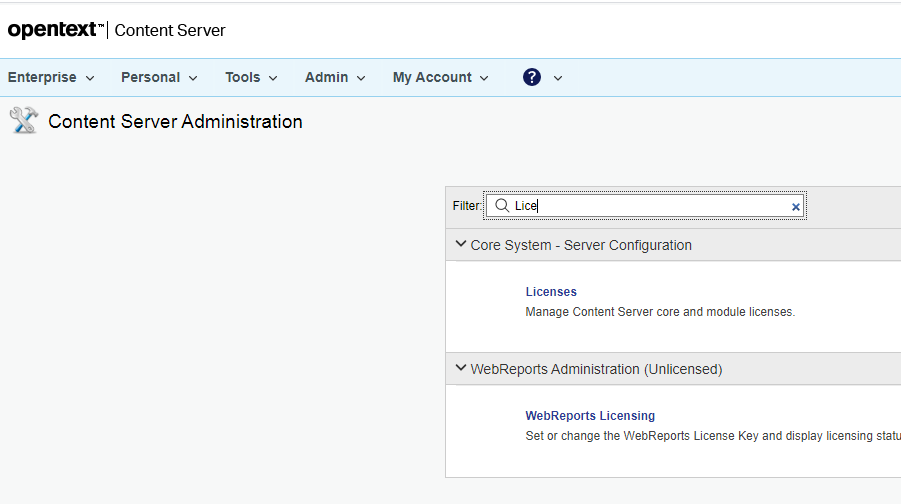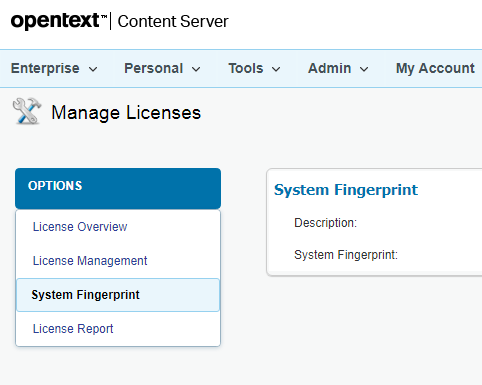Installing the Suite on Unix
Installation procedure¶
We will refer to the Content Server installation directory as %OTCS_HOME%
Unix Consultant
This manual presumes that the user executing the intallation process has a good knowledge of a Unix System and its commands
Deploy Content Server Modules¶
-
Stop the Content Server
-
Run the Module Suite Master Installer and unpack: Content Script module, Beautiful WebForms, Smart Pages modules and all the desired Module Suite Extension packages
Step-by-step procedure
The following screens will guide you through the deployment of Module Suite modules.
- Staging folder: extract ModuleSuite compressed archive file into a temporary location

- EULA : Acceptance of the end-user license agreement is mandatory for proceeding with the installation
A copy of the agreement will be available, upon installation, in:
%OTCS_HOME%/module/amcontentscript_X_Y_Z/license/EULA Accepting the End User Agreement is mandatory to proceed with the installation.
Enter “Y” when ready.

- OTHOME selection: The installer will prompt you for the location where Content Server is installed. Either confirm (ENTER) the default location or enter the correct location to proceed with the installation.

- Automatic import of Content Server dependencies: The installer will automatically attempt to load a few libraries from Content Server.
In case of failure, a warning message could appear during this phase of the installation. In such case, the operation must be performed manually -
Module Suite Extension Packages: Enter “Y” to install the extension when prompted.
CSEP SAP* - DO NOT INSTALL THEM UNLESS YOU WANT TO CONFIGURE THEM
This extension package requires the SAP™ JCo library to be available in the extension repository
<OTHOME>/module/anscontentscript_x_y_z/amlib/sapand is certified for use with SAP™ JCo version (3.0.6) when used on OpenText Extended ECM and version (3.0.10) when used on CSP. SAP™ JCo library can be downloaded from SAP™ website. More on this extensions.
-
Installation completed: return to the installation checklist to finalize the module setup.
What to do if the installer raises the error: Unable to automatically extract...
Some Content Script extension packages require two Java libraries that are specific to the target Content Server environment and are not distributed with the module.
The required library files are:
- csapi.jar
- service-api-X.X.XX.jar
and can be found in the web app located in:
%OTCS\_HOME%\\webservices\\java\\webapps\\cws.war
- classificationsservice-api-X.X.XX.jar
which can be found in the web app located in:
%OTCS\_HOME%\\webservices\\java\\webapps\\cs-services-classifications.war
- physicalobjectsservice-api-X.X.XX.jar
which can be found in the web app located in:
%OTCS\_HOME%\\webservices\\java\\webapps\\cs-services-physicalobjects.war
- recordsmanagementservice-api-X.X.XX.jar
which can be found in the web app located in:
%OTCS\_HOME%\\webservices\\java\\webapps\\cs-services-recordsmanagement.war
To retrieve the files:
- copy the file named XXX.war to a temporary folder
- rename the file XXX.war in XXX.
- extract the zip archive contents locate the files in the WEB-INF/lib folder
Once the files have been located, copy them to the folder:
%OTCS_HOME\staging\anscontentscript_x_y_z\amlib
Install Content Server Modules¶
-
Start Content Server
-
Login as Administrator and access the Module administration panel
-
Select “Install Modules”
-
From the available modules, select “AnswerModules Content Script 2.7.0”
-
Follow the installation steps and restart Content Server when prompted.
-
From the Administration Home, access the Module administration panel
-
Select “Install Modules”
-
From the available modules, select “Answer Modules - Beautiful Web Forms 2.7.0”
-
Follow the installation steps and restart Content Server when prompted.
-
From the Administration Home, access the Module administration panel
-
Select “Install Modules”
-
From the available modules, select “Answer Modules - Smart Pages 2.7.0”
-
Follow the installation steps and restart Content Server when prompted.
Activate and Configure¶
From the Administration Home, select AnswerModules Administration > Base Configuration, then enter the activation License in order to activate the product. License shall be entered in the Module Suite - Activation Key property
How do I get an activation key?
In order to activate Module Suite you need a valid activation key. Activation keys can be requested to AnswerModules Support by providing the OpenText Content Server System Fingerprint.
You can read your's environment fingerprint from the OpenText Admin Pages as shown below 

Since version 3.1.0, if the installation is performed on a multi-server architecture is no longer necessary to repeat the activation process on all the node of the cluster since the License Key information is stored in the Content Server's database.
In order to do so, there are two alternative options:
- Edit the .ini file manually on each machine, adding the licensing information.
- From the Administrative pages of each machine, perform the “save Base Configuration” operation.
-
Save the Base Configuration and restart Content Server
Installation complete
The Module Suite's initial setup is complete